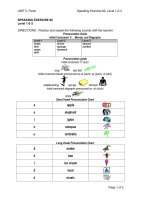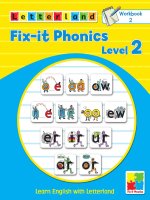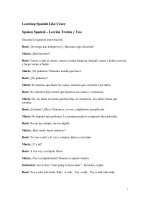earth smart level 2 readers
Bạn đang xem bản rút gọn của tài liệu. Xem và tải ngay bản đầy đủ của tài liệu tại đây (4.72 MB, 36 trang )
Earth Smart
How to Take Care
of the Environment
LESLIE
GARRETT
LESLIE
GARRETT
We can make our world a cleaner and
healthier place to live. Join Sophie
and Spencer to find out how.
DK READERS
Stunning photographs combine
with lively illustrations and engaging,
age-appropriate stories in
DK READERS
, a multilevel
reading program guaranteed to capture children’s interest
while developing their reading skills and general knowledge.
$14.99 USA
$19.99 Canada
This book is printed on 100% recycled paper and
processed chlorine free.
With DK READERS, children
will learn to readÑthen read to learn!
Jacket images
Front and back:
DK Images/Andy Crawford.
Printed in China
READERS
READERS
2
DK READERS
EARTH SMART
GARRETT
•
Rich vocabulary and challenging sentence structure
•
Additional information and alphabetical glossary
•
Comprehensive index
Procient
readers
Reading
alone
•
More complex sentence structure
•
Information boxes and alphabetical glossary
•
Comprehensive index
•
Longer sentences and increased vocabulary
•
Information boxes full of extra fun facts
•
Simple index
Beginning
to read alone
•
Word repetition, limited vocabulary,
and simple sentences
•
Picture dictionary boxes
Beginning
to read
Learning
to read
•
High-frequency words
•
Picture word strips
•
Labels to introduce and reinforce
vocabulary
Discover more at
www.dk.com
9 780756 619138
5 1 4 9 9
I S B N 0 - 7 5 6 6 - 1 9 1 3 - 0
Dinosaur Dinners
Bugs! Bugs! Bugs!
Slinky, Scaly Snakes!
Animal Hospital
The Little Ballerina
Munching, Crunching, Sniffing, and
Snooping
The Secret Life of Trees
Winking, Blinking, Wiggling,
and Waggling
Astronaut: Living in Space
Twisters!
Holiday! Celebration Days around
the World
The Story of Pocahontas
Horse Show
Survivors: The Night the
Titanic Sank
Eruption! The Story of Volcanoes
The Story of Columbus
Journey of a Humpback Whale
Amazing Buildings
Feathers, Flippers, and Feet
Outback Adventure: Australian
Vacation
Sniffles, Sneezes, Hiccups,
and Coughs
Starry Sky
Earth Smart: How to Take Care
of the Environment
Ice Skating Stars
Let’s Go Riding!
I Want to Be a Gymnast
LEGO: Castle Under Attack
LEGO: Rocket Rescue
Star Wars: Journey Through Space
MLB: A Batboy’s Day
MLB: Let’s Go to the Ballpark!
¡Insectos! en español
¡Bomberos! en español
La Historia de Pocahontas
en español
Meet the X-Men
Spider-Man: Worst Enemies
Level 2
Spacebusters: The Race
to the Moon
Beastly Tales
Shark Attack!
Titanic
Invaders from Outer Space
Movie Magic
Plants Bite Back!
Time Traveler
Bermuda Triangle
Tiger Tales
Aladdin
Heidi
Zeppelin: The Age of the Airship
Spies
Terror on the Amazon
Disasters at Sea
The Story of Anne Frank
Abraham Lincoln: Lawyer, Leader,
Legend
George Washington: Soldier, Hero,
President
Extreme Sports
Spiders’ Secrets
The Big Dinosaur Dig
Space Heroes: Amazing Astronauts
The Story of Chocolate
LEGO: Mission to the Arctic
NFL: Super Bowl Heroes
NFL: Peyton Manning
NFL: Whiz Kid Quarterbacks
MLB: Home Run Heroes: Big Mac,
Sammy, and Junior
MLB: Roberto Clemente
MLB: Roberto Clemente
en español
MLB: World Series Heroes
MLB: Record Breakers
MLB: Down to the Wire: Baseball’s
Great Pennant Races
Star Wars: Star Pilot
The X-Men School
Abraham Lincoln: Abogado, Líder,
Leyenda en español
Al Espacio: La Carrera a la Luna
en español
Level 3
READERS
A Note to Parents
DK READERS is a compelling program for beginning
readers, designed in conjunction with leading literacy
experts, including Dr. Linda Gambrell, Professor of
Education at Clemson University. Dr. Gambrell has
served as President of the National Reading Conference
and the College Reading Association, and has recently
been elected to serve as President of the International
Reading Association.
Beautiful illustrations and superb full-color
photographs combine with engaging, easy-to-read stories
to offer a fresh approach to each subject in the series.
Each DK READER is guaranteed to capture a child’s
interest while developing his or her reading skills,
general knowledge, and love of reading.
The ve levels of DK READERS are aimed at different
reading abilities, enabling you to choose the books that
are exactly right for your child:
Pre-level 1: Learning to read
Level 1: Beginning to read
Level 2: Beginning to read alone
Level 3: Reading alone
Level 4: Procient readers
The “normal” age at which a child
begins to read can be anywhere from
three to eight years old, so these
levels are only a general guideline.
No matter which level you select, you
can be sure that you are helping your
child learn to read, then read to learn!
Series Editors
U.S. Editor
Art Editor
DTP Designer
Production
Jacket Designer
Photographer
Reading Consultant
Library of Congress Cataloging-in-Publication Data
Alamy Images:
Corbis:
Ecoscene:
Getty Images:
Photographersdirect.com:
www.dk.com
R
E
A
D
E
R
S
P
R
O
F
I
C
I
E
N
T
A
L
O
N
E
R
E
A
D
I
N
G
T
O
R
E
A
D
B
E
G
I
N
N
I
N
G
T
O
R
E
A
D
A
L
O
N
E
B
E
G
I
N
N
I
N
G
2
3
1
4
READERS
“Hooray!” shouted Spencer.
“Aunt Charlotte brought us
popsicles!”
Aunt Charlotte was looking after
Spencer and his older sister, Sophie,
for the day.
Aunt Charlotte is a teacher.
Her classes are about the
environment—the world around us.
“We can all take good care
of the environment,” she told
the children.
Aunt Charlotte gave
Sophie and Spencer
their popsicles.
Spencer tore off
the wrapper
and tossed it
on the ground.
Sophie bent down to pick it up.
“We shouldn’t litter,” she said.
She dropped the wrapper
into a nearby garbage can.
Put a lid on it
Keep your environment clean
by putting litter in a garbage
can or taking it home. Keep
a lid on your can at home
so garbage doesn’t blow away.
Aunt Charlotte agreed: “We need
to keep our planet clean so
it’s a healthy place to live.”
Just then a garbage truck
stopped at the curb.
A man emptied the garbage can
into the back of the truck.
“Where is he taking
the garbage?” asked Spencer.
“It goes to a landfill,” said
Aunt Charlotte.
“That’s a huge pit in the ground
where garbage is dumped, then
covered over with earth.
After a long time, the garbage
breaks down and becomes dirt.”
Landfill site
Garbage is spread
out and covered
with earth to keep
flies away and cut
down on smell.
“We should be careful about
the garbage we throw out,”
said Aunt Charlotte.
“Some things are toxic.”
“What’s toxic?” asked Spencer.
10
“Things like cans of
paint and batteries
leak out dangerous
chemicals that can get
into our soil and water,”
replied Aunt Charlotte.
“If you have dangerous trash like
this, get your parents to take it to
a hazardous waste drop-off center,
where it will be disposed of safely.”
Batteries
You will throw
away fewer
batteries if you
use rechargeable
batteries or wind-up
radios and flashlights.
Turning the
handle charges
the radio.
11
Leaking
batteries
The children followed
Aunt Charlotte into the house.
“We throw away too much,”
Aunt Charlotte continued.
“We should recycle as
much as we can.
12
13
That means saving things
like glass bottles,
plastic food wrappers,
and cans, so they can be
reused or melted down
and turned into
something else.”
A vase made from
recycled glass
Drink cans
Aluminum cans
can be recycled over
and over again.
The metal always stays
strong and flexible.
14
“Let’s set up recycling boxes,”
said Sophie.
She found three big boxes
and stuck labels on that said
“paper,” “plastic,” and
“glass and cans.”
Spencer found some old
newspapers his mother was
going to throw away.
He put them in the “paper”
recycling box.
Recycling bins
If your recycling boxes
are not collected, you
can empty them into
recycling bins at a
local drop-off point.
15
16
“Another way to help our planet
is to save electricity,”
said Aunt Charlotte.
“Power plants burn fuel
to make electricity,” she said.
“Smoke from the burning fuel
makes the air dirty.”
Spencer coughed.
“We breathe the pollution,”
he said.
“Without clean air, we get sick,”
said Sophie.
Aunt Charlotte nodded.
“And so can our planet,” she said.
17
18
“The pollution in the air traps heat
and makes the planet heat up,”
explained Aunt Charlotte.
“This is called global warming.
Ice is melting at both the North
and South Poles.
Melting snow
Global warming is
making snow melt
on Africa’s tallest
mountain, Mount
Kilimanjaro.
This means there will be more
floods, and people and animals
will lose their homes.”
19
“If we use less electricity,
we will make less pollution,”
said Aunt Charlotte.
“Do you know how we can
use less at home?” she asked.
“We can turn off lights when
we don’t need them,” suggested
Spencer, as he turned off a light.
“We can read
books instead of
watching TV,”
added Sophie.
The TV was on,
so Sophie
turned it off.
20
21
22
Later they all set out for the park.
“Phew,” said Spencer as they
walked beside a busy road.
“What’s that smell?”
23
“That’s exhaust from the car
engines,” said Aunt Charlotte.
“It pollutes the air.”
“If we walk, we’ll cut down on
pollution,” Sophie suggested.
Aunt Charlotte nodded.









